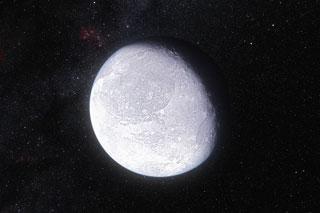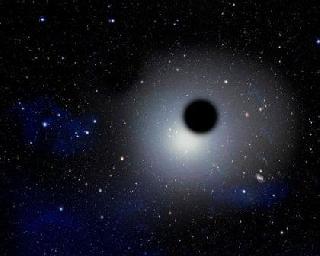
This artist's impression shows the distant dwarf planet Eris. New observations have shown that Eris is smaller than previously thought and almost exactly the same size as Pluto. Photo: ESO/L. Calcada.
CHILE (BNS): Astronomers have measured the diameter of the dwarf planet Eris by catching it as it passed in front of a faint star.
This was seen by telescopes in Chile, including the TRAPPIST telescope at ESO's La Silla Observatory.
The observations show that Eris is an almost perfect twin of Pluto in size and appears to be covered in a layer of ice, according to a news report by ESO.
In November 2010, the distant dwarf planet Eris passed in front of a faint background star, an event called an occultation.
The candidate star for the occultation was identified by studying pictures from the MPG/ESO 2.2-metre telescope at ESO's La Silla Observatory. The observations were carefully planned and carried out by a team of astronomers from a number of (mainly French, Belgian, Spanish and Brazilian) universities using - among others - the TRAPPIST (TRAnsiting Planets and PlanetesImals Small Telescope) telescope, also at La Silla, the news report added.
"Observing occultations by the tiny bodies beyond Neptune in the Solar System requires great precision and very careful planning. This is the best way to measure Eris's size, short of actually going there," astronomer Bruno Sicardy, the lead author, was quoted as saying in the report.
The combined observations from the two Chilean sites indicate that Eris is close to spherical. These measurements should accurately measure its shape and size as long as they are not distorted by the presence of large mountains. Such features are, however, unlikely on such a large icy body.
Eris was identified as a large object in the outer Solar System in 2005. Its discovery was one of the factors that led to the creation of a new class of objects called dwarf planets and the reclassification of Pluto from planet to dwarf planet in 2006. Eris is currently three times further from the Sun than Pluto.
The surface of Eris was found to be extremely reflective, reflecting 96% of the light that falls on it. This is even brighter than fresh snow on Earth, making Eris one of the most reflective objects in the Solar System, along with Saturn's icy moon Enceladus.
"This layer of ice could result from the dwarf planet's nitrogen or methane atmosphere condensing as frost onto its surface as it moves away from the Sun in its elongated orbit and into an increasingly cold environment," Emmanuel Jehin, who contributed to the study, added.
The new results also allow the team to make a new measurement for the surface temperature of the dwarf planet. The estimates suggest a temperature for the surface facing the Sun of -238 Celsius at most, and an even lower value for the night side of Eris.
 Previous Article
Previous Article Next Article
Next Article













The Indian Air Force, in its flight trials evaluation report submitted before the Defence Ministry l..
view articleAn insight into the Medium Multi-Role Combat Aircraft competition...
view articleSky enthusiasts can now spot the International Space Station (ISS) commanded by Indian-American astr..
view article